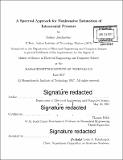| dc.contributor.advisor | Thomas Heldt. | en_US |
| dc.contributor.author | Jaishankar, Rohan | en_US |
| dc.contributor.other | Massachusetts Institute of Technology. Department of Electrical Engineering and Computer Science. | en_US |
| dc.date.accessioned | 2017-10-18T15:09:54Z | |
| dc.date.available | 2017-10-18T15:09:54Z | |
| dc.date.copyright | 2017 | en_US |
| dc.date.issued | 2017 | en_US |
| dc.identifier.uri | http://hdl.handle.net/1721.1/111916 | |
| dc.description | Thesis: S.M., Massachusetts Institute of Technology, Department of Electrical Engineering and Computer Science, 2017. | en_US |
| dc.description | Cataloged from PDF version of thesis. | en_US |
| dc.description | Includes bibliographical references (pages 97-101). | en_US |
| dc.description.abstract | Intracranial pressure (ICP) is an important clinical indicator of neurological injury and is used in the diagnosis, treatment and monitoring of several neurological pathologies. Current measurement modalities of ICP are highly invasive, largely limiting the measurement to critically ill patients. An accurate noninvasive method to estimate ICP would dramatically expand the patient pool for which this important cranial vital sign becomes available. This work expands upon a model-based spectral approach to estimate ICP from arterial blood pressure (ABP) and cerebral blood flow velocity (CBFV) measurements. To support such ICP estimation, we developed a data acquisition system to archive high quality, high resolution waveforms from various bedside monitoring devices along a common time axis and deployed the system at the neurocritical care units at Boston Medical Center. The system has been used to collect 21 hours of high quality data from twelve patients over one year. We have improved upon past attempts at estimating ICP by implementing a model-based spectral approach and capturing the relationship between the ABP and ICP waveforms. Our algorithm has been validated for estimating ICP on a clinical dataset of 185 minutes of high quality data from three patients. The algorithm is accurate and has a mean estimation error of -2.4 mmHg, a standard deviation of the error of 3.6 mmHg and a root mean squared error of 5.1 mmHg, which are all within the clinically relevant range. These contributions take a step towards realizing the goal of implementing a real-time noninvasive ICP estimation modality in a clinical setting. | en_US |
| dc.description.statementofresponsibility | by Rohan Jaishankar. | en_US |
| dc.format.extent | 101 pages | en_US |
| dc.language.iso | eng | en_US |
| dc.publisher | Massachusetts Institute of Technology | en_US |
| dc.rights | MIT theses are protected by copyright. They may be viewed, downloaded, or printed from this source but further reproduction or distribution in any format is prohibited without written permission. | en_US |
| dc.rights.uri | http://dspace.mit.edu/handle/1721.1/7582 | en_US |
| dc.subject | Electrical Engineering and Computer Science. | en_US |
| dc.title | A spectral approach for noninvasive estimation of intracranial pressure | en_US |
| dc.type | Thesis | en_US |
| dc.description.degree | S.M. | en_US |
| dc.contributor.department | Massachusetts Institute of Technology. Department of Electrical Engineering and Computer Science | |
| dc.identifier.oclc | 1005701003 | en_US |
